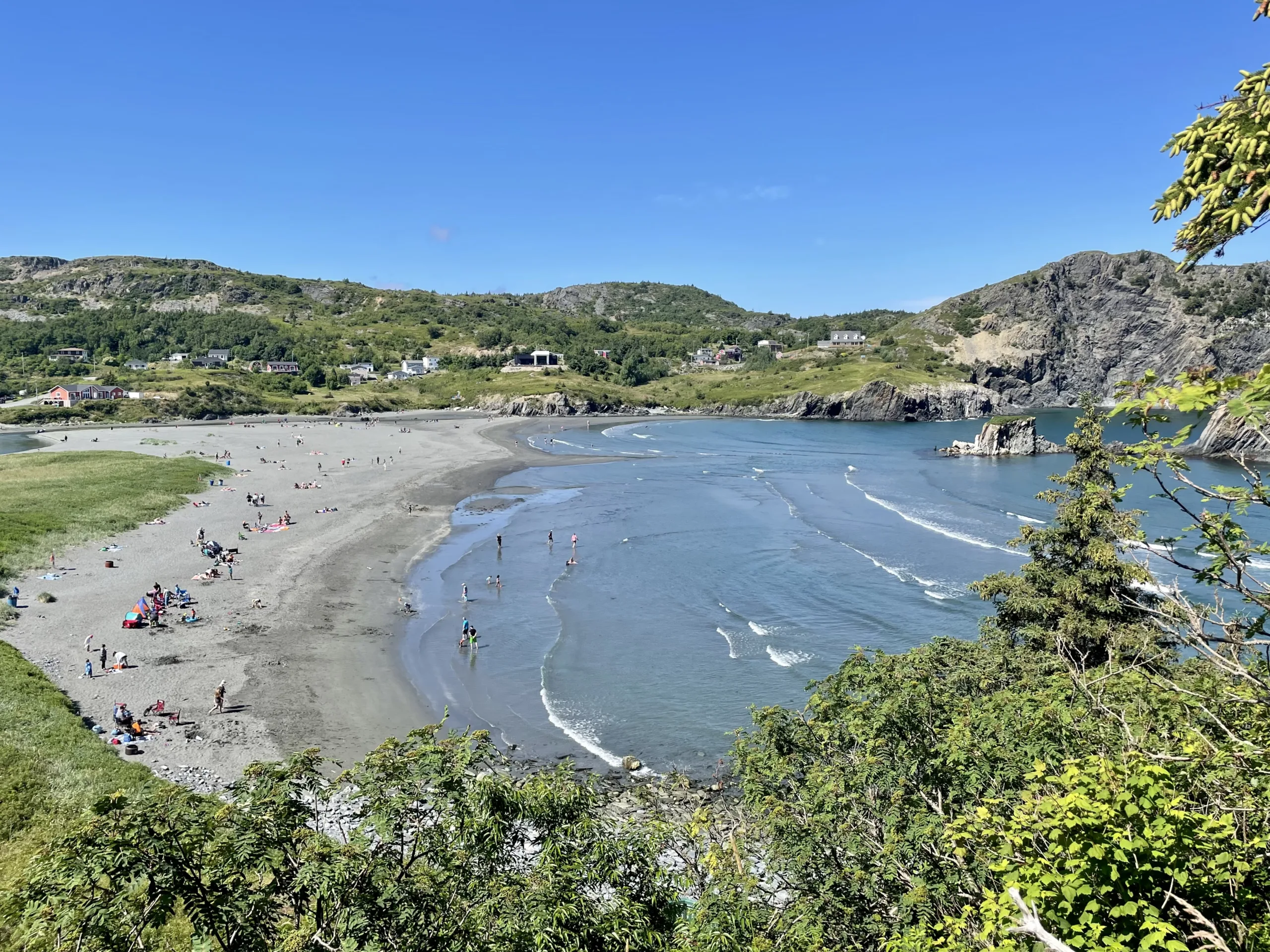Best Places To Travel In 2024 For An Amazing Experience
These are some of the best places to travel in 2024 for an amazing experience in Newfoundland. In the ever-evolving travel landscape, Newfoundland is a captivating destination for those seeking an unparalleled experience in 2024. Nestled on the eastern coast of Canada, this enchanting province offers breathtaking landscapes, rich cultural heritage, and unique adventures.
Exploring St. John’s – The Vibrant Capital:
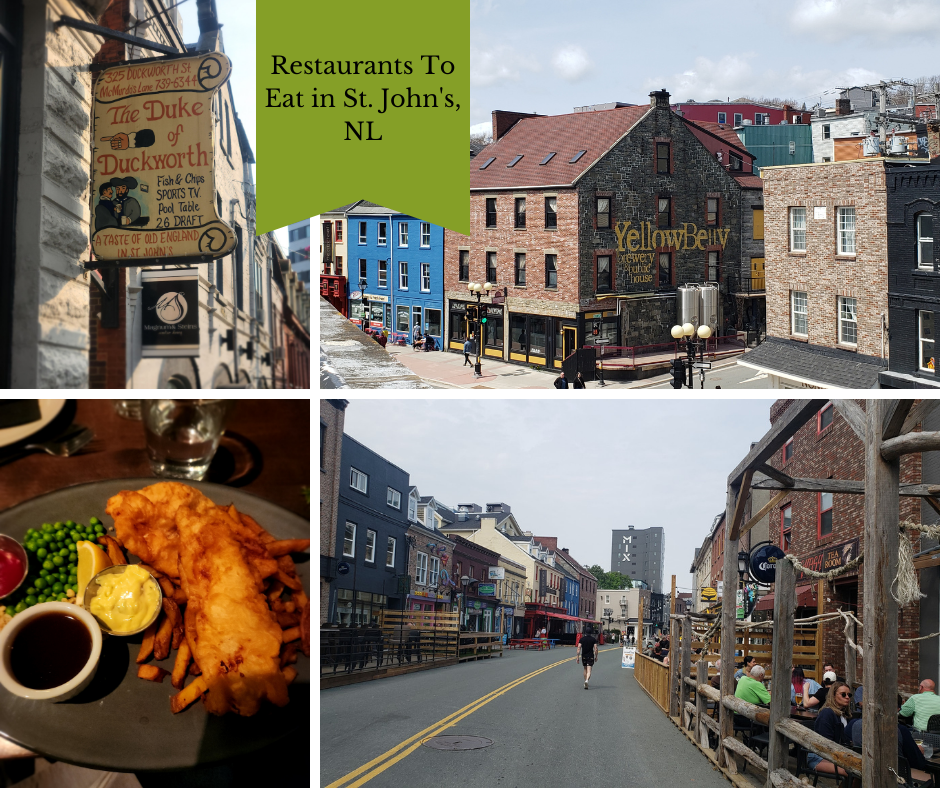
Embark on your Newfoundland adventure by immersing yourself in the vibrant culture of St. John’s, the capital city. Wander through the colourful row houses of Jellybean Row, each façade telling a unique story. Don’t miss Signal Hill, where history and natural beauty collide, providing panoramic views of the Atlantic Ocean.
Visiting St. John’s, Newfoundland, promises a unique and enriching experience that sets it apart as a must-see destination.
Colourful Architecture and Quaint Charm: St. John’s is renowned for its picturesque and colourful row houses, famously known as Jellybean Row. Walking through the charming streets feels like stepping into a living canvas, providing a delightful backdrop for your exploration.
Rich Cultural Heritage: Immerse in the rich cultural heritage of St. John’s, where historical sites like Signal Hill and Cape Spear offer glimpses into the region’s past. The city has a deep connection to its seafaring history, and you can explore museums and heritage sites that tell stories of maritime adventures.
Lively Arts and Entertainment Scene: St. John’s boasts a thriving arts and entertainment scene. Experience the vibrant atmosphere of George Street, known for its lively pubs and music venues. The city hosts numerous festivals annually, celebrating music, film, literature and food.
Stunning Coastal Views: Perched on the edge of the Atlantic Ocean, St. John’s provides breathtaking coastal views. Signal Hill offers panoramic vistas of the sea, and hiking trails like the North Head Trail allow one to appreciate the rugged beauty of the coastline.
Friendly Locals and Warm Hospitality: Newfoundlanders are known for their warmth and friendliness, and St. John’s is no exception. Engage in conversations with locals, and you’ll likely find yourself immersed in the genuine hospitality that makes visitors feel welcome and at home.
Unique Cuisine and Culinary Delights: St. John’s offers a culinary experience like no other. Indulge in local delicacies such as Jigg’s dinner, touton, and the freshest seafood from the Atlantic Ocean. The city’s dining scene reflects the region’s Atlantic heritage, providing a delicious journey for your taste buds.
Iceberg Alley: St. John’s is a gateway to Iceberg Alley, where massive ice formations journey from Greenland. Take a boat tour to witness these natural wonders up close, creating a once-in-a-lifetime inspiring and unique experience.
Quirky and Memorable Experiences: From kissing the cod during a traditional screech-in ceremony to exploring the vibrant local markets, St. John’s offers many quirky and memorable experiences that add a touch of whimsy to your visit. St. John’s, Newfoundland, beckons with its blend of history, culture, natural beauty, and warm hospitality. Whether you’re an adventure seeker, a history enthusiast, or simply looking for a charming getaway, St. John’s will captivate your heart and leave you with lasting memories.
Rental Cars: For visitors looking for rental cars for their trip to Newfoundland and Labrador. We have many car rental options to suit different budgets and preferences.
Hi, let’s have a fireside chat.
What are the must-visit attractions in St. John’s, Newfoundland?
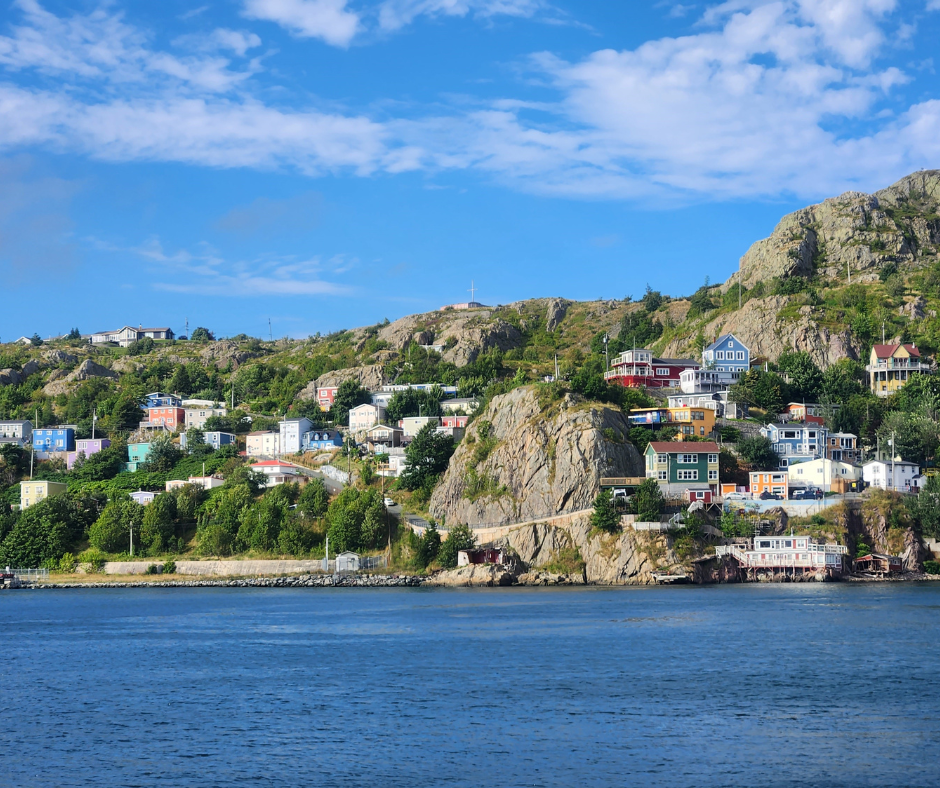
St. John’s offers a plethora of attractions. Catch Signal Hill, Jellybean Row, and The Rooms for a cultural experience. Explore the historic Cape Spear, the easternmost point of North America, and indulge in the lively atmosphere of George Street.
When is the best time to visit St. John’s for good weather?
From June to August, the summer months provide St. John’s most favourable weather conditions. Mild temperatures and more extended daylight make it ideal for outdoor exploration and activities.
Are there hiking trails near St. John’s with scenic views?
Absolutely! The East Coast Trail offers breathtaking views along rugged coastal landscapes. Hike the Signal Hill Trail or explore scenic paths in nearby areas like Cape Spear for a memorable outdoor experience.
What unique food experiences can I have in St. John’s?
St. John’s is known for its seafood delicacies. Try Jigg’s dinner, touton, and fresh catches at local restaurants. Remember to experience a traditional Newfoundland boil-up for an authentic culinary adventure.
How can I get to Fogo Island from St. John’s?
Fogo Island is accessible by ferry from Farewell. You can take a ferry to Fogo Island from Change Islands.
What festivals are held in St. John’s throughout the year?
St. John’s hosts various festivals celebrating music and culture, including the George Street Festival. The St. John’s International Women’s Film Festival and the Royal St. John’s Regatta are popular events showcasing the city’s vibrant spirit.
What are some budget-friendly accommodation options in St. John’s?
St. John’s offers a range of accommodations, from cozy bed and breakfasts to budget-friendly hotels. Consider options like guesthouses and hostels for affordable stays while experiencing local hospitality.
Are there guided tours available in St. John’s for exploring the city?
Yes, guided tours are available for exploring St. John’s. Consider walking tours to delve into the city’s history and culture or boat tours to explore the coastline and witness icebergs during the right season.
What is the best way to explore the vibrant nightlife on George Street?
George Street comes alive at night with its vibrant pubs and live music. The best way to explore the nightlife is by walking, allowing you to hop from one lively venue to another and soak in the energetic atmosphere.
Can I see icebergs in St. John’s, and when is the best time for iceberg watching?
You can witness icebergs in St. John’s, especially during the spring and early summer. The best time for iceberg watching is from April to June, when these majestic formations drift along the coast, creating a spectacular sight.
Discovering Gros Morne National Park:
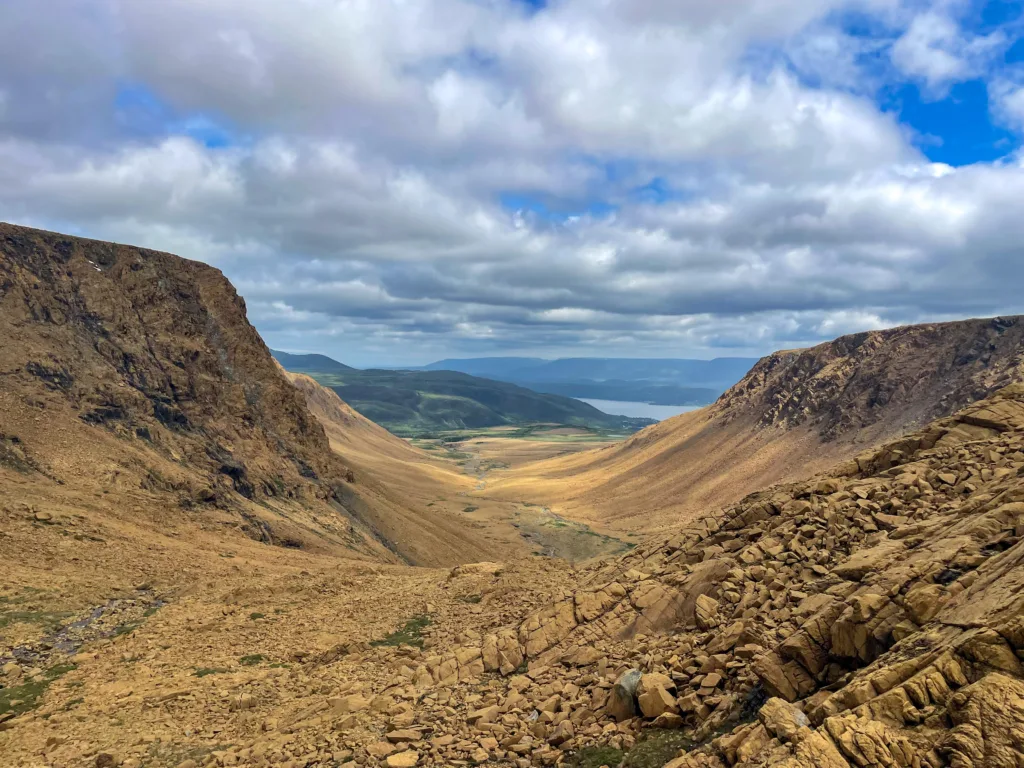
Gros Morne National Park, a UNESCO World Heritage Site, beckons with its dramatic landscapes. Hike the Gros Morne Mountain, a challenging yet rewarding ascent that unveils sweeping vistas of fjords and mountains. Immerse yourself in the geological wonders, from Tablelands to the serene waters of Western Brook Pond. Discovering Gros Morne National Park is a compelling and enriching experience for several reasons, such as its natural beauty, adventure, and cultural richness. Here are compelling reasons to explore Gros Morne National Park:
World Heritage Site: Gros Morne National Park holds the prestigious UNESCO World Heritage Site title. This designation is a testament to the park’s outstanding geological features, including the Tablelands and Gros Morne Mountain. As a visitor, you have the opportunity to witness and explore landscapes that have been recognized globally for their significance.
Dramatic Landscapes and Unique Geology: The park boasts diverse landscapes, from towering cliffs and fjords to dense forests and meadows. The Tablelands, a striking barren plateau, offers a surreal and otherworldly experience. Gros Morne Mountain is one of the highest peaks in Newfoundland and provides panoramic views of the surrounding beauty, rewarding hikers with a sense of accomplishment.
Abundant Hiking Opportunities:
If you’re an outdoor enthusiast, Gros Morne National Park is a paradise for hiking. Gros Morne National Park has well-maintained trails catering to various skill levels, so you can choose an adventure that suits your preferences. Gros Morne National Park offers challenging hikes like Gros Morne Mountain and more leisurely walks through coastal trails.
Rich Biodiversity:
Gros Morne National Park is home to a diverse range of plants, which makes it a haven for nature lovers. Watch for moose, caribou, and various bird species while exploring the park. The ecosystems within Gros Morne contribute to the region’s ecological importance, providing a glimpse into the interconnected web of life.
Boat Tours and Fjord Exploration:
Venture into the heart of Gros Morne’s coastal wonders by taking a boat tour through the fjords. Witnessing the towering cliffs rise from the water and the pristine beauty of the fjords is a captivating experience that adds an Atlantic dimension to your exploration of the park.
Cultural Heritage and Local Communities:
Beyond its natural wonders, Gros Morne National Park is enriched with cultural heritage. Engage with local communities and discover the unique traditions and stories that have shaped the region. Attend cultural events and gain insights into the Newfoundland way of life, adding a human touch to your visit.
Hi, let’s have a fireside chat.
What are the must-see attractions in Gros Morne National Park?

Gros Morne National Park boasts stunning landscapes and attractions. Take advantage of Gros Morne Mountain, Western Brook Pond, and the Tablelands for breathtaking views and unique geological formations.
How do I get to Gros Morne National Park from St. John’s?
The most common way is to fly from St. John’s to Deer Lake, the nearest airport to Gros Morne. From Deer Lake, it’s about a 1.5-hour drive to the park. Alternatively, you can drive by taking the TCH on a scenic road trip, exploring Newfoundland’s beauty.
When is the best time to explore Gros Morne National Park grounds?
The best time to explore Gros Morne National Park is from late spring to fall when the weather is mild. Summer offers pleasant temperatures and longer daylight hours, making it ideal for hiking and exploring.
Are there guided tours available in Gros Morne National Park?
Various guided tours are available, from boat tours in Western Brook Pond to hiking tours exploring the park’s diverse landscapes. Confirm with local tour operators for options that suit your interests.
What are the camping options in Gros Morne National Park?
Gros Morne offers camping facilities, including Parks Canada campgrounds and private campgrounds nearby. Please book reservations, especially during peak summer months.
Can you see icebergs in Gros Morne National Park?
While icebergs are more common in areas like Iceberg Alley, some may drift near Gros Morne’s coast. Spring and early summer offer better chances of spotting these majestic ice formations.
What wildlife can be encountered in Gros Morne National Park?
Gros Morne is home to diverse wildlife, including moose, caribou, foxes, and various bird species. Please keep your eyes peeled during hikes and scenic drives for a chance to observe these animals in their natural habitat.
Are there dining options within Gros Morne National Park?
You’ll find dining options within the park, from casual eateries to more formal restaurants. As a larger city, St. John’s offers various dining choices before or after your Gros Morne adventure.
What are some recommended day trips from St. John’s to Gros Morne National Park?
While Gros Morne is a journey from St. John’s, consider stopping at scenic points like Twillingate or Terra Nova National Park.
A Coastal Retreat in Trinity:
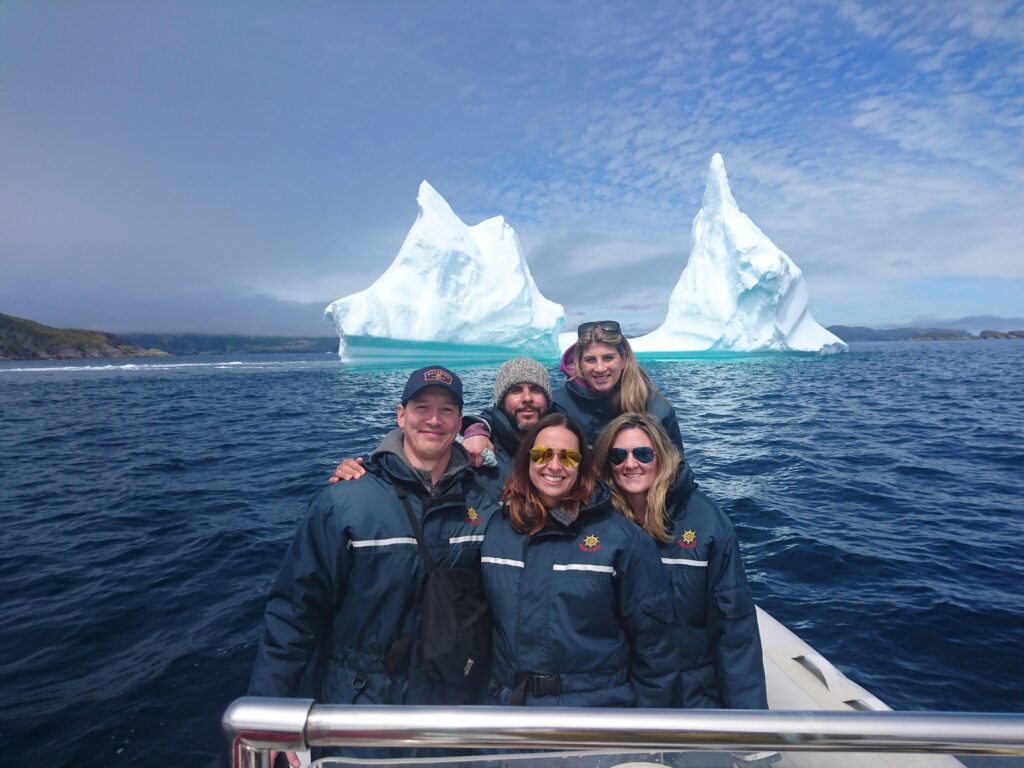
For a tranquil coastal experience, venture to Trinity. This historic town exudes charm with its well-preserved architecture and a vibrant arts scene. Explore the Rising Tide Theatre and relish the Atlantic atmosphere on the trails in Trinity, which offers stunning coastal views.
Historical Charm: Trinity is a town steeped in history, dating back centuries. Walking through Trinity streets feels like stepping back in time as you encounter well-preserved architecture, including traditional wooden houses and historic churches. The town’s authenticity and charm create a captivating atmosphere that history enthusiasts and casual explorers alike will appreciate.
Rising Tide Theatre: Trinity is home to the renowned Rising Tide Theatre, a cultural gem that enhances the town’s appeal. This theatre company offers captivating performances that delve into Newfoundland and Labrador rich cultural heritage, combining drama, music, and storytelling. Attending a play at the Rising Tide Theatre in Trinity provides a unique and immersive way to connect with the local history and traditions. Address: 40 West Street, Trinity, NL, Canada, and Tel: 1 888-464-3377
More Ways to Explore Newfoundland and Labrador
- What You Need to Know for Taking the Newfoundland Ferry Ride
- Taking the Ferry to Argentia Newfoundland
- Marine Atlantic Ferry From Nova Scotia To Newfoundland
- Best Places To Travel In 2024 For An Amazing Experience
- The Best Amazing Restaurants in St. John’s to eat out
- 15 Beautiful and Unique Things To Do In Newfoundland
- Out Of The Ordinary Things To Do In St. John’s
- Exploring The Unique and Beautiful Culture of Newfoundland
- Hiking On The Beautiful Brigus Lighthouse Trail
Scenic Coastal Beauty:
Nestled on the rugged coastline of Newfoundland, Trinity boasts breathtaking views of the Atlantic Ocean. The picturesque setting, backdrop of rolling hills and serene waters make Trinity the perfect destination for those seeking tranquillity. Exploring the coastline, whether on foot or by taking a boat tour, allows you to appreciate the stunning landscapes fully.
Trinity Trail:
For outdoor enthusiasts, Trinity offers Trails that provide excellent opportunities to explore the town’s surroundings. The scenic trail takes you through forests along the coastline and offers panoramic views of Trinity and the neighbouring areas. Hiking trails in Trinity allow you to connect with nature while enjoying the fresh air and stunning vistas. One of the trials you must hike is Gun Hill Trail.
Cultural Festivals and Events:
Trinity hosts various cultural festivals and events throughout the year, providing visitors an immersive experience. From music festivals celebrating traditional Newfoundland tunes to cultural events showcasing local arts and crafts, the town offers a vibrant cultural scene. Attending these festivities allows you to engage with the community and better understand Newfoundland’s cultural richness. Access the Town of Trinity – Historic Town of Trinity website to get up-to-date event information.
Quaint Accommodations and Local Cuisine:
Trinity offers a range of charming accommodations, including bed and breakfasts and cozy inns, allowing visitors to stay in settings that complement the town’s historic charm. Local restaurants and eateries also serve delicious Newfoundland cuisine featuring fresh seafood and traditional dishes. Exploring the local culinary scene becomes a delightful part of your Trinity experience.
Hi, let’s have a fireside chat.
What are the must-visit attractions in Trinity, Newfoundland?

Trinity, Newfoundland, boasts a rich history and vibrant culture. Must-visit attractions include the Rising Tide Theatre, Trinity Loop Trail, and the historic architecture of this charming coastal town.
What is the best time to visit Trinity for optimal weather?
The best time to visit Trinity is during the summer when the weather is mild and outdoor activities are in full swing. However, early fall can also offer pleasant weather with fewer crowds.
How do I get to Trinity, Newfoundland?
Trinity is accessible by road, and you can drive from St. John’s. Alternatively, you can fly to St. John’s International Airport and then drive to Trinity, enjoying the picturesque landscapes.
Are there guided tours available in Trinity?
Yes, Trinity offers various guided tours, providing insight into the town’s history, culture, and natural beauty. Guided boat tours are popular for exploring the coastal wonders, and walking tours showcase the town’s historic sites.
What are the best hiking trails in and around Trinity?
Trinity boasts scenic hiking trails, with the Trinity Loop Trail being a highlight for its coastal views. The Skerwink Trail and Gun Hill Trail are popular options, offering a mix of natural beauty and historical landmarks.
Are there any festivals or events in Trinity throughout the year?
Trinity hosts several festivals and events, including the Trinity Pageant, showcasing the town’s history through live performances.
What accommodation options are available in Trinity?
Trinity offers a range of accommodation options, from cozy bed and breakfasts to historic inns. Some popular choices include Fisher’s Loft Inn, Artisan Inn, and Campbell House Bed & Breakfast.
Can you visit historical sites in Trinity?
Absolutely! Trinity is rich in history, and visitors can explore sites like the Lester-Garland House, Hiscock House Provincial Historic Site, and the Green Family Forge to glimpse the town’s past.
Are there opportunities for whale watching in Trinity?
Yes, Trinity offers exciting whale-watching opportunities. Tour operators provide boat excursions where you can spot humpback whales, minke whales, and even orcas in the surrounding waters.
What local cuisines should I try in Trinity?
Make sure to try local Newfoundland delicacies in Trinity. Seafood enthusiasts can indulge in freshly caught fish, crab, and lobster. Additionally, traditional dishes like touton and Jigg’s dinner offer a good taste of the region’s culinary heritage.
Is Trinity pet-friendly for travellers with pets?
While some accommodations may be pet-friendly, checking with individual establishments in advance is advisable. Trinity’s outdoor spaces, like hiking trails, can be enjoyable for pet owners but always adhere to local regulations.
Iceberg Alley – Nature’s Spectacle:
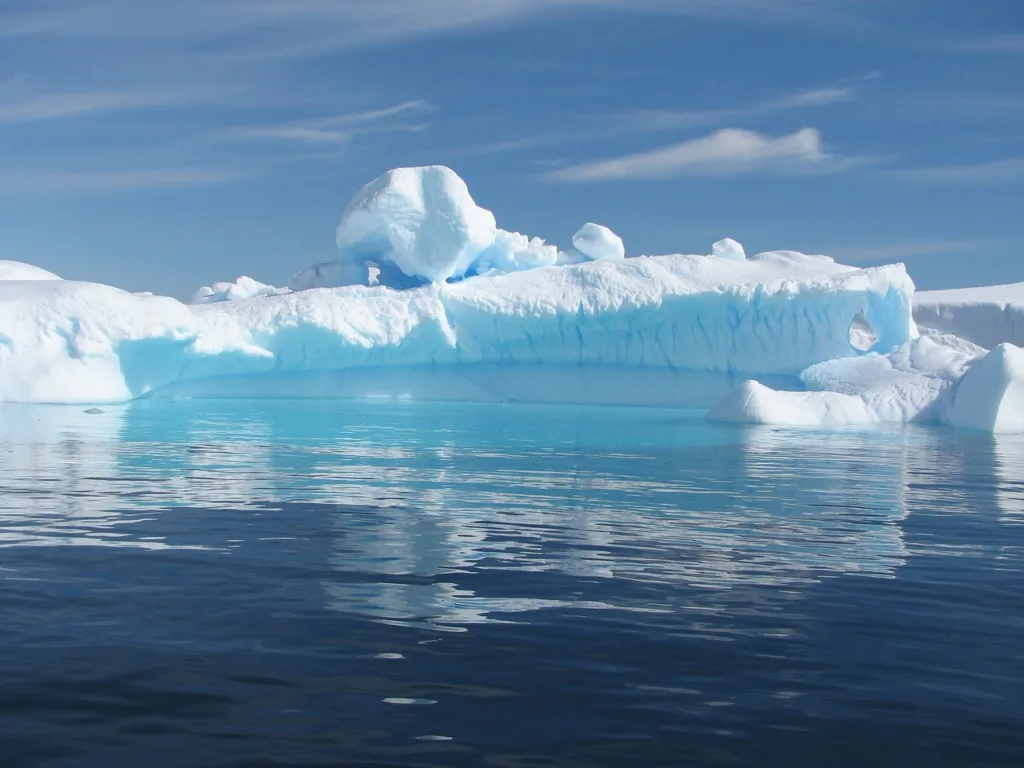
In 2024 and beyond, witness the inspiring beauty of Iceberg Alley. These colossal ice formations drift from the Labrador Sea’s cold water, creating a rare and mesmerizing visual spectacle. Take a boat tour to get up close and personal with these icy giants while learning about their journey through expert guides. Discovering Iceberg Alley in Newfoundland is an experience that transcends the ordinary, offering a myriad of reasons why this natural wonder should be on your travel radar from 2024 to future years.
Spectacular Natural Phenomenon: Iceberg Alley, stretching along the coast of Newfoundland and Labrador, is a breathtaking display of nature’s grandeur. Witnessing these colossal ice formations from western Greenland is a rare spectacle that evokes awe and wonder. These icebergs’ sheer magnitude and beauty create a visual effect for the senses, making them a must-see for any nature enthusiast.
Unique Photographic Opportunities: For photography enthusiasts, Iceberg Alley provides a dreamlike backdrop for capturing stunning images. The play of sunlight on the ice, the contrast with the deep blue Atlantic Ocean, and the diverse shapes and sizes of the icebergs create a photographer’s paradise. Each iceberg tells a story, and capturing its essence through a lens is an artistic endeavour that promises unparalleled results.
Limited-Time Experience: Iceberg season in Newfoundland typically runs from spring to early summer, making it a limited-time experience. Planning a visit during this period ensures that you catch these floating giants at their most majestic. This exclusivity adds to the allure, encouraging travellers to seize the opportunity and witness a natural spectacle only available for a short window each year.
Boat Tours for a Close Encounter: To truly immerse yourself in the magic of Iceberg Alley, consider taking a boat tour. These guided excursions offer a close encounter with the icebergs, allowing you to appreciate their size and beauty from a unique perspective. Knowledgeable guides share insights into the formation of icebergs, their journey along the coast, and their impact on the local ecosystem.
A blend of Adventure and Serenity: Navigating through Iceberg Alley presents a harmonious blend of adventure and serenity. The tranquil waters, interrupted by the presence of these majestic ice formations, create a surreal atmosphere. Whether you observe from a boat or hike along the coastline, the experience is thrilling and peaceful, providing a perfect balance for those seeking diverse travel encounters.
Educational Insights into Climate Change: Iceberg Alley offers more than just visual appeal. Iceberg Alley serves as a poignant reminder of the impact of climate change. The icebergs that find their way to Newfoundland and Labrador shores have broken off from glaciers, highlighting the environmental changes around us.
Hi, let’s have a fireside chat.
What is Iceberg Alley in Newfoundland?

Iceberg Alley is a renowned stretch of the Atlantic Ocean along the coast of Newfoundland and Labrador, where massive icebergs drift. This natural phenomenon provides a spectacular display of colossal ice formations, making it a unique and awe-inspiring destination.
When is the best time to visit the Iceberg Alley area in Newfoundland and Labrador?
The prime time to witness icebergs in Iceberg Alley is generally from late spring to early summer, typically from May to June or July. During this period, the warmer temperatures cause icebergs to travel from glaciers, creating a captivating spectacle for visitors.
How can I get close to icebergs in Iceberg Alley?
Several tour operators in Newfoundland offer boat tours that take you close to the icebergs in Iceberg Alley. These tours provide a safe and thrilling experience, allowing you to marvel at these natural wonders’ sheer size and beauty while learning about their formation and journey.
Are there specific viewing points for Iceberg Alley in Newfoundland?
While boat tours are the most popular way to experience Iceberg Alley up close, several coastal viewpoints and hiking trails along the Newfoundland coastline offer stunning vantage points. Signal Hill in St. John’s and various locations along the East Coast Trail provide excellent views.
What other attractions are near Iceberg Alley in Newfoundland?
Newfoundland offers a myriad of attractions near Iceberg Alley. Gros Morne National Park, L’Anse aux Meadows, and Fogo Island are just a few destinations for their natural beauty, cultural richness, and historical significance.
Are there safety precautions for iceberg viewing tours? Yes, safety is paramount during iceberg viewing tours. Tour operators provide life jackets and safety briefings.
Can I see wildlife while visiting the Iceberg Alley in Newfoundland?
Absolutely! Iceberg Alley is a spectacle of ice and a haven for marine life. Keep a lookout for whales, seals, and seabirds during your iceberg tour, enhancing your overall experience with the diverse wildlife of the Atlantic.
What should I pack for a trip to Iceberg Alley?
Pack layers, waterproof clothing, and comfortable footwear. The weather can be unpredictable, and it’s advisable to be prepared for varying conditions. Bring an excellent, high-quality camera to capture the stunning scenery and wildlife in the area.
Are there guided tours available for Iceberg Alley in Newfoundland?
Numerous guided tours operate in Newfoundland, offering informative and enriching experiences. Whether by boat or on land, these adventure tours provide insights into the geological and ecological aspects of Iceberg Alley.
How long should I plan for a trip to Iceberg Alley?
The duration of your trip depends on what you plan to do. A few days to a week is often sufficient to explore Iceberg Alley, including nearby attractions. Choose the activities you wish to engage in and plan for a well-rounded experience.
Culinary Delights and Seafood Extravaganza:

Every visit to Newfoundland is complete with savouring its delectable seafood. Indulge in the freshest catches at local eateries, where traditional dishes like Jigg’s dinner and Touton showcase the region’s culinary prowess. Don’t forget to pair your meal with a pint of local brew – an authentic Newfoundland experience. Embarking on a culinary delight and seafood extravaganza in Newfoundland is an experience that promises to tantalize your taste and provide a unique culinary journey.
The freshness of seafood: Newfoundland’s proximity to the Atlantic Ocean ensures you’ll savour some of the freshest seafood available. Each dish celebrates the region’s Atlantic bounty, from succulent lobster and crab to tender cod and mussels. The seafood is often caught locally and prepared with a commitment to preserving its natural flavours.
Rich Culinary Heritage: The province boasts a rich culinary heritage deeply rooted in history and cultural influences. Traditional Newfoundland dishes, such as Jigg’s dinner (a hearty meal with salt beef, root vegetables, and pease pudding) and touton (fried dough), taste the region’s authentic and wholesome fare. These dishes have been passed down through generations, reflecting the warmth of Newfoundland culinary traditions.
Unique Local Ingredients: The culinary scene in Newfoundland embraces unique local ingredients that showcase the province’s diverse landscapes. Foraged berries, wild game, and locally sourced produce add a distinctive touch to the dishes, creating an authentic and memorable dining experience.
Craft Beer and Local Brews: Complement your seafood feast with craft beers and locally brewed beverages. Newfoundland burgeoning craft beer scene offers a range of options to pair with your meals, enhancing the overall culinary experience. Enjoy a few pints of locally brewed ale while overlooking the picturesque coastal landscapes.
Warm Hospitality and Local Insights:
Engage with the locals and experience Newfoundland renowned hospitality as you dine in charming restaurants and eateries. The chefs often share stories behind the dishes, providing insights into the cuisine’s cultural significance.
The Tranquil Islands of Fogo and Change Islands:
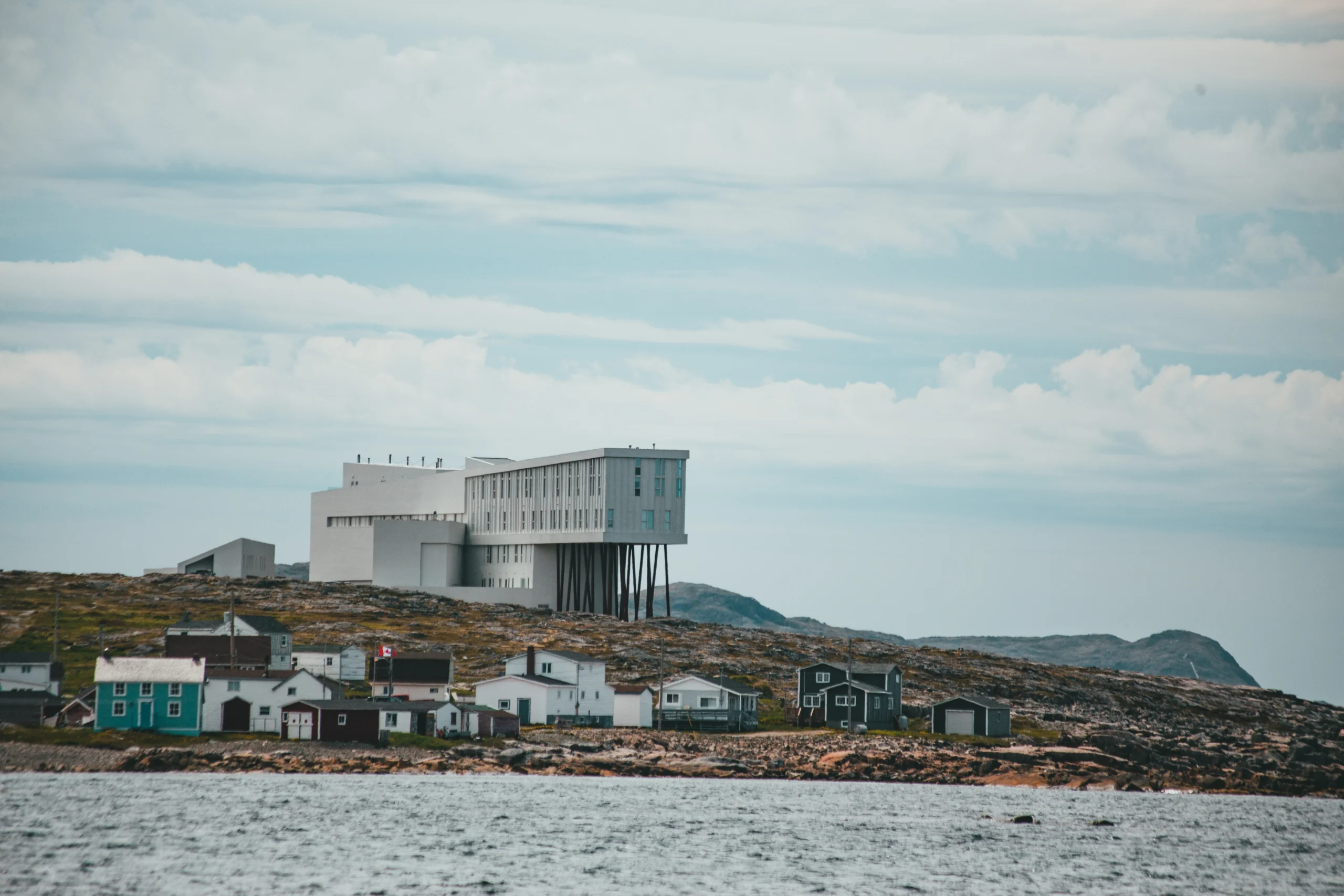
Escape the hustle and bustle of mainland Newfoundland by visiting the serene Fogo Island and Change Islands. Fogo Island, known for its artist residencies and contemporary architecture, offers a peaceful retreat surrounded by the North Atlantic’s beauty. Stroll through the picturesque villages of Change Islands, where time seems to stand still amidst colourful clapboard houses and rocky shores.
Serenity and Escape: Fogo and Change Islands offer a serene escape from everyday life. The islands’ peaceful atmospheres, characterized by picturesque landscapes and a slower pace of living, create the perfect setting for relaxation and rejuvenation. These islands are an idyllic destination if you seek a tranquil retreat surrounded by nature’s beauty.
Change Islands’ Quaint Villages and Timeless Charm: With its vibrant clapboard houses and untouched landscapes, Change Islands exudes timeless charm. The island’s small villages provide a glimpse into Newfoundland rich cultural heritage. Strolling through these picturesque settlements feels like a step back in time, offering an authentic and immersive experience.
Scenic Beauty and Outdoor Exploration: Fogo and Change Islands boast stunning coastal scenery and opportunities for outdoor exploration. The islands provide diverse landscapes, from rocky shorelines and sandy beaches to rolling hills. Hiking trails offer breathtaking views, allowing you to connect with nature and experience the islands’ untamed beauty firsthand. The tranquil Islands of Fogo and Change Islands beckon with their unique combination of serenity, artistic flair, cultural richness, and breathtaking landscapes. Whether you’re seeking a peaceful retreat, exploring contemporary art, or tasting Newfoundland Atlantic history, these islands offer an unforgettable and immersive experience.
Hi, let’s have a fireside chat.
What makes Fogo Island and Change Islands in Newfoundland unique destinations?

Fogo Island and Change Islands are distinctive for their serene landscapes, traditional charm, and artistic communities. Fogo Island is known for contemporary architecture and artist residencies, while Change Islands offers a glimpse into a more straightforward, coastal way of life.
How do I get to Fogo Island and Change Islands?
To reach Fogo Island, take a ferry from Farewell or fly to Gander and then take a ferry. Change Islands are accessible by ferry from Farewell. Plan your transportation based on ferry schedules and availability.
What are the must-see attractions on Fogo Island?
Explore contemporary architecture, enjoy artist residencies, visit local museums, and take in the scenic beauty of Fogo Island.
What outdoor activities are available on Fogo Island and Change Islands?
Both islands offer excellent hiking opportunities. Fogo Island has scenic trails, while Change Islands provide a tranquil atmosphere for leisurely walks. Explore the islands’ unique coastlines, capturing stunning views and encountering local wildlife.
Are there accommodations on Fogo and Change Islands?
Yes, both islands offer a range of accommodations, from bed and breakfasts to boutique hotels.
What’s the best time to visit Fogo Islands and Change Islands?
The summer months, from June to August, offer the best weather for outdoor activities. However, some travellers prefer the quieter shoulder seasons for a more intimate experience.
Can I see icebergs from Fogo and Change Islands?
Yes, both islands are part of the Iceberg Alley route. However, iceberg sightings are seasonal, with the best chances from April to June or July. Consider taking a boat tour for a closer look.
What activities are available in Iceberg Alley, Newfoundland?
Iceberg Alley offers boat tours, allowing visitors to witness majestic ice formations. The region’s hiking, photography, and cultural experiences are also prevalent.
What are the main attractions on Fogo Islands and Change Islands?
Fogo Islands and Change Islands boast a variety of attractions for visitors to explore. On Fogo Island, highlights include:
- The striking contemporary architecture of the Fogo Island Inn.
- The rugged coastline of Joe Batt’s Arm.
- The quaint fishing communities of Tilting.
Change Islands are known for their historic clapboard houses, scenic coastal trails, and rich maritime history.
Are there guided tours available on Fogo Islands and Change Islands?
Yes, visitors can choose from various guided tours and experiences to enhance their visit to Fogo Islands and Change Islands. Local guides offer informative tours of historic sites, cultural landmarks, and natural attractions. Specialized tours focusing on photography, birdwatching, or culinary experiences are also available.
Can I visit Fogo Islands and Change Islands on a day trip from the Newfoundland mainland?
While visiting Fogo Islands and Change Islands as a day trip from the Newfoundland mainland, many visitors can stay overnight to fully experience the island’s tranquillity and charm. However, day trippers can still explore key attractions and enjoy outdoor activities during their visit.
Travelling to Newfoundland and Labrador. Travelers also ask.
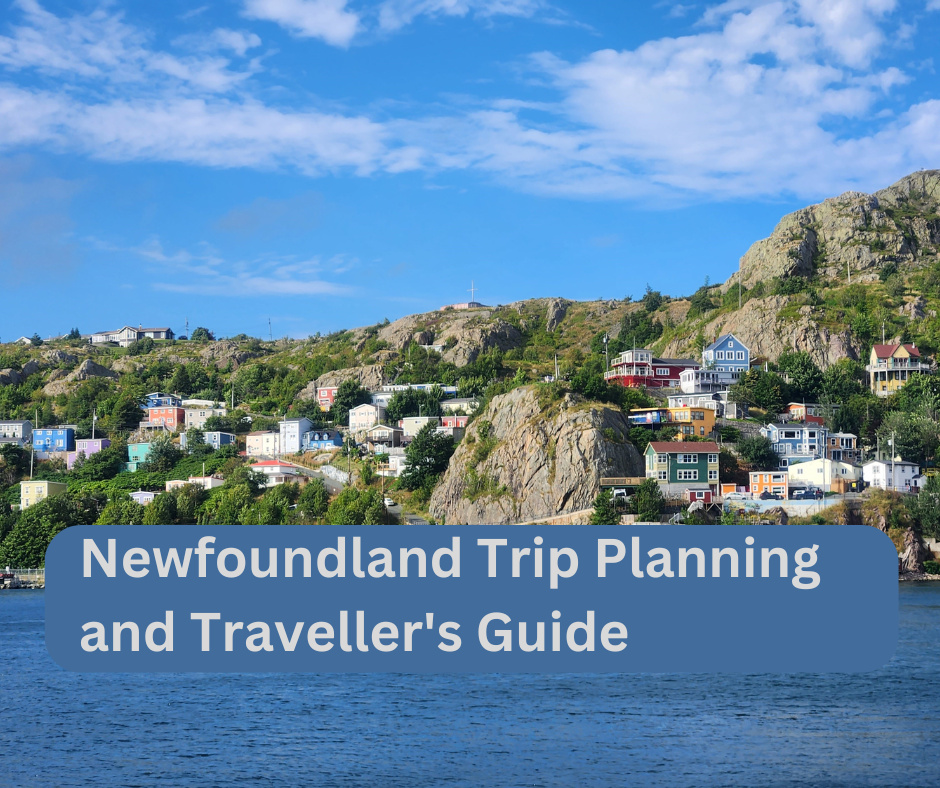
Can you see icebergs in Newfoundland now?
Icebergs are typically seen off the coast of Newfoundland from late spring to early summer. The best months for iceberg viewing are usually May and June. If it’s within this timeframe, you can likely see icebergs, especially in areas like Twillingate and St. Anthony.
When to see icebergs in Twillingate?
The prime time to see icebergs in Twillingate is from late May to early June. This period offers the highest likelihood of witnessing these massive ice formations as they drift southward along the coast.
Where is the best place to see icebergs?
The best places to see icebergs in Newfoundland include Twillingate, St. Anthony, Bonavista, and Fogo Island. Twillingate is often called the “Iceberg Capital of the World” due to its high iceberg count and accessibility.
What is the best month to see icebergs in Newfoundland?
The best month to see icebergs in Newfoundland is May. During this month, the icebergs are plentiful, and the weather is often more favourable for boat tours and coastal viewing.
How long do icebergs last in Newfoundland?
Icebergs can last from a few weeks to several months in Newfoundland waters. Their longevity depends on their size, the water temperature, and the weather conditions. Typically, icebergs seen off Newfoundland begin their journey from Greenland and take about 1-2 years to reach the island.
Where is Newfoundland Iceberg Alley?
Iceberg Alley refers to the stretch of ocean off the coast of Newfoundland and Labrador, where icebergs are commonly seen. It extends from the coast of Labrador down through Newfoundland’s eastern shore, including areas like Twillingate, St. Anthony, and Bonavista.
Are there icebergs in Newfoundland in August?
By August, the number of icebergs in Newfoundland significantly decreases. While it’s possible to see the occasional iceberg, they are much rarer than the peak months of May and June.
What month is the warmest in Newfoundland?
July is typically the warmest month in Newfoundland, with a temperatures ranging from 15°C to 20°C. This makes it a popular time for visitors seeking to explore the island’s natural beauty.
Where to see whales in Newfoundland?
Whale watching is popular in Newfoundland from June to September. The best locations include St. John’s, Trinity, Bonavista, and Witless Bay Ecological Reserve, renowned for its abundant marine life, including humpback whales.
Can you see the Northern Lights from Newfoundland?
You can see the Northern Lights from Newfoundland, particularly in the more northern and remote parts of the island. The best times are during the fall and winter when the nights are the longest and the skies are the darkest.
How close to Newfoundland did the Titanic sink?
The Titanic sank about 370 miles south-southeast off the coast of Newfoundland. The nearest land to the wreck site is the southeastern tip of Newfoundland.
How close is the Titanic to Newfoundland?
The Titanic’s wreck is located approximately 370 miles off the coast of Newfoundland. This proximity made Newfoundland a critical point in the communication and rescue efforts following the disaster.
Where did the Titanic sink off Newfoundland?
The Titanic sank in the Atlantic Ocean, approximately 370 miles south-southeast of Newfoundland coast.
Are there polar bears in Newfoundland?
Polar bears are not native to Newfoundland itself, but they occasionally appear on the northern coast of Labrador, particularly when sea ice drifts south from the Arctic.
What is the iceberg capital of Canada?
Twillingate, a small coastal town in Newfoundland, is known as the “Iceberg Capital of the World” due to its frequent and spectacular iceberg sightings during the peak season.
How fast do icebergs move?
Icebergs generally drift at about 0.7 kilometres per hour (0.4 miles per hour). However, their speed can vary depending on ocean currents, winds, and the iceberg’s size.
Why are icebergs sometimes black?
Icebergs appear black when they contain a high amount of sediment and debris. This can occur when icebergs calve off glaciers that scrape the land, picking up rocks and soil, which then get frozen into the ice.
Does the Atlantic Ocean in Newfoundland freeze?
The Atlantic Ocean around Newfoundland does not freeze over due to its relatively warmer temperatures than Arctic waters. However, sea ice and icebergs from the Arctic can drift into Newfoundland waters, especially during the spring.
Are there puffins in Twillingate?
While puffins are not commonly found in Twillingate, they are prevalent in other parts of Newfoundland, such as the Witless Bay Ecological Reserve. Twillingate is more famous for its iceberg and whale sightings.
What is the best time to see whales in NL Newfoundland?
The best time to see whales in Newfoundland is from June to September. Humpback whales, minke whales, and other species migrate through Newfoundland coastal waters during this period.
Is the tip of the iceberg visible?
Yes, the tip of the iceberg is visible above the water, but it represents only about 10% of its total mass. The remaining 90% is submerged underwater, making icebergs particularly dangerous for ships.
Can you see icebergs in Newfoundland in July?
Yes, you can still see icebergs in July in Newfoundland, although they are less common than in May and June. By July, many icebergs have drifted further south or melted.
Where is the best place to see icebergs?
Twillingate, St. Anthony, Bonavista, and Fogo Island are the best places to see icebergs in Newfoundland. These locations offer optimal viewing points and tour opportunities.
How often can you see northern lights in Newfoundland?
The Northern Lights can be seen in Newfoundland several times a year, especially in the fall and winter months. The frequency depends on solar activity and the clarity of the night skies.
Why is it called Iceberg Alley?
The stretch of water known as Iceberg Alley gets its name from the numerous icebergs that travel through this area each year. The icebergs originate from Greenland and drift down the Labrador Current past Newfoundland and Labrador.
When should I visit Iceberg Alley?
The best time to visit Iceberg Alley is from late May to early June. During this period, the highest concentration of icebergs can be seen, offering the most spectacular views.
Can you swim in Newfoundland in August?
Yes, you can swim in Newfoundland in August, especially in the warmer, sheltered areas like lakes and coves. However, the ocean waters remain pretty cold, typically around 12-15°C, so swimming in the sea can be chilly.
How hot is Newfoundland in July?
Newfoundland experiences its warmest weather in July, with a temperatures ranging from 15°C to 20°C. Some days can be warmer, especially inland and away from the coastal breezes.
Is St. John’s, Newfoundland, worth visiting?
St. John’s, the capital, is worth visiting. St. John’s offers a rich cultural heritage, a vibrant arts scene, and breathtaking natural landscapes. Known for its colourful row houses, historic sites like Signal Hill, and picturesque harbour, St. John’s provides a unique blend of natural beauty. The city’s friendly locals, lively music scene, and excellent seafood add to its charm, making it a must-visit destination.
What is St. John’s, Newfoundland, famous for?
St. John’s is famous for several things:
- Signal Hill: This historic site offers panoramic views, and the Cabot Tower is where the first transatlantic wireless communication was received.
- George Street is renowned for its nightlife, with the most bars and pubs per capita in North America.
- Colourful Row Houses: Known as Jellybean Row, these brightly painted homes are iconic.
- Rich History: As one of the oldest cities in North America, it has a rich maritime history and cultural heritage.
How many days does it take to visit St. John’s, Newfoundland?
To fully experience St. John’s and its surroundings, a visit of 4 to 5 days is recommended. This allows time to explore the city’s historical sites, enjoy the local cuisine, enjoy the nightlife on George Street, and venture out to nearby natural attractions such as Cape Spear and Quidi Vidi Village.
Is St. John’s, Newfoundland, a walkable city?
Yes, St. John’s is a walkable city, especially in the downtown area, where many attractions, restaurants, and shops are concentrated. The city’s hilly terrain can be challenging, but it also offers beautiful vistas and charming streets to explore on foot.
What is the best month to visit Newfoundland?
The best months to visit Newfoundland are from late June to early September. The weather is milder during this period, and you can enjoy outdoor activities like hiking, whale watching, and iceberg spotting. July and August are viral for tourists.
What is the best time of year to visit St. John’s, Newfoundland?
The best time to visit St. John’s is during the summer, from June to early September, during this this time the weather is warm and many festivals and events occur. This is also the peak season for whale-watching and iceberg viewing.
Is St. John’s Newfoundland expensive?
St. John’s can be moderately expensive, especially during peak tourist season. Accommodation, dining, and activities can add up, but budget-friendly options are also available. Compared to larger Canadian cities, St. John’s is relatively affordable.
Is Newfoundland expensive to visit?
Newfoundland is not excessively expensive to visit, but costs can vary depending on the time of year and type of accommodation. While certain activities and dining experiences may be costly, there are plenty of free or low-cost activities to enjoy.
What is the famous street in St. John’s, Newfoundland?
George Street is famous in St. John’s for its vibrant nightlife and numerous bars and pubs. George Street is a popular spot for locals and tourists looking to experience live music and socialize.
Can you get around St. John’s without a car?
Yes, you can get around St. John’s without a car, especially downtown, where many attractions are within walking distance. You’ll have access to convenient transportation options, such as public transportation, taxis, and ride-sharing services.
How long is the ferry ride from Nova Scotia to St. John’s, Newfoundland?
There is no direct ferry to St. John’s. However, you can take a ferry from North Sydney, Nova Scotia, to either Argentia (a 16-hour ride) or Port aux Basques (a 6–8-hour ride) in Newfoundland. From there, you must drive to St. John’s, which takes approximately 1.5 hours from Argentia or 9 hours from Port aux Basques.
How long does it take to drive around St. John’s?
Driving around St. John’s can take about an hour, depending on traffic and stops. Exploring the greater St. John’s area, including nearby attractions like Cape Spear and Quidi Vidi, can take several hours.
What is the crime rate in St. John’s, Newfoundland?
St. John’s has a relatively low crime rate compared to other Canadian cities. While it experiences typical urban crime, it is generally considered a safe place for residents and visitors.
How cheap is Newfoundland?
Newfoundland is relatively affordable compared to other parts of Canada. While some areas, especially St. John’s, can be expensive, smaller towns and rural areas, however, offer more budget-friendly options for accommodation and dining.
What is the best way to tour Newfoundland?
The best way to tour Newfoundland is by car. This allows you to explore the island’s diverse landscapes, remote villages, and natural attractions at your own pace. Renting a car is recommended if you’re flying into the province.
In what month do you see icebergs in Newfoundland?
Iceberg season in Newfoundland typically runs from late May to early June, though icebergs can sometimes be seen as late as July. The best month for iceberg viewing is usually June.
What is the best month to see icebergs in Newfoundland?
June is generally the best month to see icebergs in Newfoundland. This is when most icebergs drift along the coast, providing spectacular viewing opportunities.
When can I see puffins in Newfoundland?
Puffins can be seen in Newfoundland from late May to early September. The best months to see them are June and July when they are most active during their breeding season.
What is the wettest month in Newfoundland?
October is typically the wettest month in Newfoundland, and it experiences the highest average rainfall.
When can you see whales in St John’s, Newfoundland?
Whale-watching season in St. John’s is from mid-June to mid-August. During this time, humpback, minke, and other whale species migrate through the waters of Newfoundland.
What should I pack for St. John’s, Newfoundland?
When visiting St. John’s, pack layers to accommodate varying weather conditions. Essentials include:
- Waterproof jacket and footwear
- Warm clothing (sweaters, hats, gloves)
- Comfortable walking shoes
- Sunscreen and sunglasses
- Cameras and binoculars for wildlife and iceberg viewing
Can you see the Northern Lights from Newfoundland?
You can watch the Northern Lights (Aurora Borealis) from Newfoundland, particularly in low-light pollution areas. The best time to see them is from late fall to early spring.
Where is the best place to see whales and icebergs in Newfoundland?
Twillingate and Bonavista are Newfoundland best places to see whales and icebergs. These coastal areas offer excellent viewing opportunities and tours.
Are there polar bears in Newfoundland?
Polar bears are occasionally seen in the northern parts of Newfoundland and Labrador, particularly in the Labrador region. They are not commonly found in Newfoundland itself.
How long does it take to drive from one end of Newfoundland to the other?
Driving from the western end of Newfoundland (Port aux Basques) to the eastern end (St. John’s) takes approximately 9–10 hours without significant stops.
Is Fogo Island worth visiting?
Fogo Island is worth visiting for its unique culture, stunning landscapes, and renowned Fogo Island Inn. It offers a distinctive experience of Newfoundland’s heritage and natural beauty.
How often can you see northern lights in Newfoundland?
The Northern Lights can be seen in Newfoundland several times a year, particularly during periods of high solar activity. The best times are during winter when nights are longer and darker.
What is the best time to see the Northern Lights?
The best time to see the Northern Lights is during the winter, from late September to early April, particularly around midnight or early morning.
How long is the ferry ride to Fogo?
The ferry ride to Fogo Island from Farewell, Newfoundland, takes approximately 45 minutes to an hour.
How much is the ferry to Fogo Island?
As of the latest information, the ferry to Fogo Island costs around $15–20 CAD per vehicle and additional fees for passengers, but prices can vary, so it’s best to check current rates.
What is so special about Fogo Island?
Fogo Island is unique for its rugged natural beauty, traditional outport culture, and the acclaimed Fogo Island Inn. It’s known for its artistic community, distinctive architecture, and stunning coastal Scenery.
Are there narwhals in Newfoundland?
Narwhals are typically found in Arctic waters and are uncommon in Newfoundland.
Are there dolphins in Newfoundland?
Yes, dolphins can be seen in the waters around Newfoundland, including species like the Atlantic white-sided dolphin and the common dolphin.
Are there killer whales in Newfoundland?
Killer whales (orcas) are occasionally sighted around Newfoundland, especially during summer.
What is Cape Spear known for?
Cape Spear is known for being the easternmost point in North America. It features a historic lighthouse and offers stunning 180-degree views of the Atlantic Ocean, making it a popular tourist spot.
Where can I see whales in Newfoundland?
Some of the best places to see whales in Newfoundland include:
- St. John’s and Cape Spear
- Trinity and Bonavista
- Twillingate
- Witless Bay Ecological Reserve
How do you see puffins in St John’s?
To see puffins near St. John’s, visit the Witless Bay Ecological Reserve island, which is home to large colonies of puffins. Boat tours from Bay Bulls can take you close to the puffin nesting sites.
How long do you need to see Newfoundland?
Plan to spend at least 7–19 days to see Newfoundland highlights. This allows enough time to explore St. John’s, the Avalon Peninsula, Gros Morne National Park, and other key attractions.
When should I go to Newfoundland?
The best time to visit Newfoundland is from late June to early September when the weather is mild. You can enjoy outdoor activities, events, and festivals. This period is also ideal for whale-watching and iceberg-viewing.
These are the best travel planning resources you should use.
Looking to book your trip to Newfoundland and Labrador? Use these resources that are tried and tested by other travellers like you who vacation in Newfoundland and Labrador. Bookmark these links. Save them for future reference.
Booking Flights, Hotels or B&B: Start planning your next vacation trip by finding the best flight, hotel or b&b deals. Book Here
Finding things to do in Newfoundland and Labrador on TripAdvisor and Viator is not hard. Enjoy boat tours, whale watching, icebergs watching, kayaking and other activities.
You can also find low prices on hotels, B&B and cabins with these two providers. If you are located in Canada, the USA, the UK or Europe, use Booking.com, and if you are in Canada, the USA or anywhere else, use TripAdvisor.
Car Rental: Here is what we recommend:
When you book with Rentalcars.com, you can compare prices and find the best vehicle for your trip. Economybookings.com Display all their vehicle on the website with a detailed description. They display high-quality photos and a user rating as well. Qeeq.com serves road trip travellers like you from different countries by working with car rental companies worldwide.
Get compensated if your flight is delayed or cancel
AirHelp and Compensateair will help you with flight delays, cancellations, or denied boarding. All you need to do is to submit your flight details, and they will handle the claim process on your behalf. They will handle all the paperwork, airline negotiations, and legal proceedings.
Do you need more help planning your trip?
Check out our Resources Page, where we highlight all the resources and companies you can use to assist with your planning.
Where can I find more information about travelling to Newfoundland and Labrador? Here are helpful resources for planning your trip:
Newfoundland and Labrador Tourism | Travel Canada | The Rooms Provincial Museum

